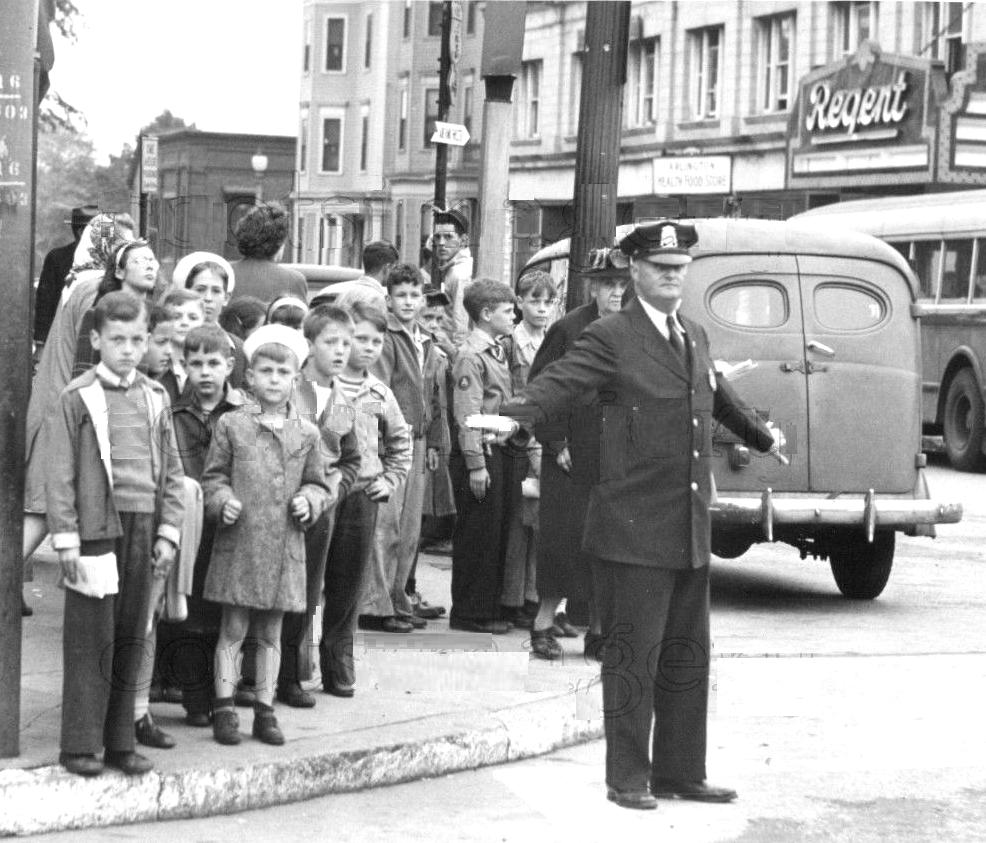
Regular U.S. School Headwear: Types--Caps

Figure 1.--Children commonly wore headwear to school in the 19th and early-20th century. This had changed dramtically by the mid-20th century. Notice here even on a cool day, very few children have headwear. We do see two boys wearing swabbie sailor caps which were popular during World War II. The photiograph here was taken during 1944. Officer Charles J. Tynan in Arkington, N=Massachusetts is teaching the children how to cross a busy intersectioin with a new traffic signsl, waiting for both red and yellow lights.
|
|
We do not see American school children wearing many caps until the end of the 19th century, hats were more common. The exception here was cold weather caps often with ear flsops. Thry may have appeared earlier. We also see a few affluent boys wearing Scottish styles at mid-century. This followed Queen Victoria's infatuation with all things scottish and dressing the pribces in kilts. The fashion soon crossed the Ataltic, at least for fashionble, well=to-do children. We rarely, however, see the Scottish caps used for school wear. We see some sailor caps in the 1890s, but we are not sure just when hey frst appeared. We also see winter caps. After the-turn-of-the century, caps relaced hats as the primary school headwear. We see peaked caps, flat caps, beanies, swabbie caps, ski caps. logging caps, and other styles. Logging caps were a regional, style, popular in the extreme north. It was the flat cap that emerged as the standard for American boys along with knickers. Peaked caps did not disappear and wre adoptd as unifoirm item for some private schools, influenced by Bitish trend. Flat caps declined in popularity during the 1930s. Headwear of any kind became less common, except during the winter or on rainy day. This reflected general trends. During World War II we see sailor Swabbie caps. Some boys began wearing baseball caps to school in the post-War years. Far fewer children wear any kind of headwear to school in the 21st centuy, exceot in cold or rainy weather.
HBC

Related Chronolgy Pages in the Boys' Historical Web Site
[Main Chronology Page]
[The 1900s]
[The 1910s]
[The 1920s]
[The 1930s]
[The 1940s]
[The 1950s]
[The 1960s]
[The 1970s]
[The 1980s]
[The 1990s]
[The 2000s]
Navigate the Relate Boys Historical Clothing Style Pages
[Main country page]
[Long pants suits]
[Short pants suits]
[Lederhosen]
[Kneesocks]
[Eton suits]
[Jacket and trousers]
[Blazer
[School sandals]
Navigate the Boys' Historical Clothing School Uniform Pages
[Return to the Main U.S. school regular headwear type page]
[Return to the Main U.S. school regular headwear page]
[Return to the Main U.S. school regular garment page]
[Return to the Main U.S. school garment page]
[Return to the Main National School Uniform Page]
[Australia]
[England]
[France]
[Germany]
[Ireland]
[Italy]
[Japan]
[New Zealand]
[Poland]
[Singapore]
[Scotland]
[Singapore]
[United States]
Navigate the HBC School Section:
[About Us]
[Activities]
[Chronology]
[Clothing styles]
[Countries]
[Debate]
[Economics]
[Garment]
[Gender]
[Hair]
[History]
[Home trends]
[Literary characters]
[School types]
[Significance]
[Transport and travel
[Uniform regulations]
[Year level]
[Other topics]
[Images]
[Links]
[Registration]
[Tools]
[Return to the Historic Boys' School Home]
Created: 6:28 AM 5/3/2018
Last updated: 6:28 AM 5/3/2018




